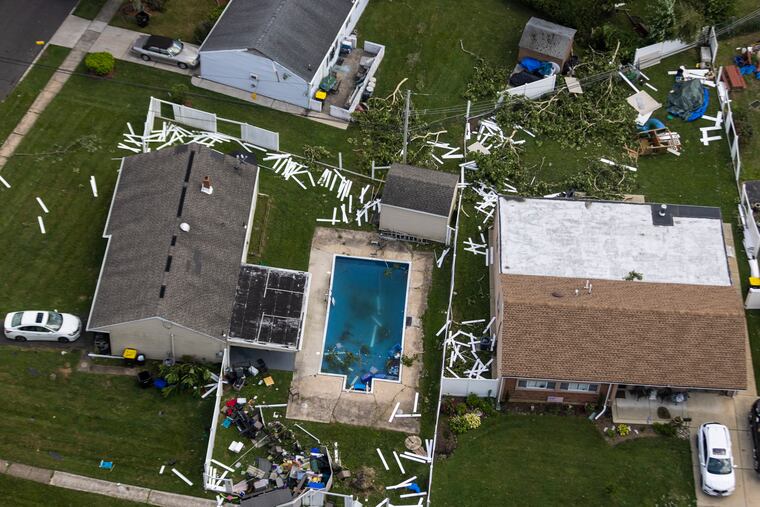Tornado count from last week’s outbreak in Philly region is at 9, and still climbing
An unusually high number of "supercell thunderstorms" ignited the outbreak, the weather service says.

The tornado count from last week’s incredible “supercell thunderstorm” outbreaks stood at nine on Monday, and it was likely to grow, the National Weather Service said.
The agency still was looking at damages in the areas of Fort Dix in Burlington County and Fullerton in Lehigh County to determine if they were the result of tornadoes, said Sarah Johnson, a lead meteorologist at the Mount Holly office.
For a variety of reasons, it was unclear whether Thursday’s outbreak set any kind of local records, but the number of verified tornadoes already has exceeded the eight spawned by Tropical Storm Isaias last August in the office’s coverage territory, which includes most of eastern Pennsylvania and New Jersey.
» READ MORE: Tornado that hit Bucks was an EF3 with winds of 140 mph: ‘I’d never seen anything like it, except on television.’
The twisters Thursday afternoon and night were set off by an unusually high number of “supercell thunderstorms,” said Johnson.
She said that while ordinarily “straight-line winds” are the primary agents of storm damage, in this case most of it occurred along or near the tornadoes’ paths, the most powerful being the one that devastated parts of Bensalem Township, Bucks County.
It ranked as an EF-3 on the Enhanced Fujita scale, with winds of 140 mph, beginning its career in Somerton in Northeast Philadelphia, traveling 3.5 miles, and carving a 530-yard damage path over eight minutes.
It crossed County Line Road into Trevose, crossed back into Philly briefly, and began intensifying when it returned to Bucks. It caused significant damage to the Faulkner Buick/GMC showroom and ripped apart the service garage.
» READ MORE: Tornado counts have spiked dramatically around Philly and elsewhere. Here’s what is behind the surge.
“The wind rushing through the garage area carried debris, car parts, and tools well away from the structure,” the weather service investigators said. Some vehicles were destroyed, “from large pieces of flying debris or from being tossed and dropped back onto the ground.”
The EF-2 that struck New Hope and skipped into Mercer County had peak winds of 120 mph and traveled a 6.4-mile path — more than double the average for a tornado in this region. It was spawned by the same supercell thunderstorm that had generated a weaker twister in Plumstead Township, survived a full 15 minutes, and caused extensive tree damage.
The wind estimates in tornadoes are inferred from damage patterns, a method pioneered by the late Theodore Fujita, a legendary storm researcher at the University of Chicago, who created the Fujita Scale, or F scale.
» READ MORE: ‘Mr. Tornado,’ in one of history’s greatest detective feats, measured the immeasurable
To derive the wind speeds, Fujita had chartered Cessnas for low-flying surveillance of tornado aftermaths and built a collection of thousands of photographs from which he was able to infer wind speeds.
Fujita had been part of a Japanese research team that examined the nuclear destruction of Hiroshima and Nagasaki in 1945 and observed destruction patterns similar to those he would later see from tornadoes.
The weather service tweaked the ratings in 2007 — thus the term “Enhanced Fujita” or EF Scale. An F3 required a peak wind of at least 158 mph; an EF3, 136 mph. That’s one reason tornado records are difficult to compare with those of earlier years.
In addition, said Harold Brooks, senior scientist at the National Severe Storms Laboratory in Norman, Okla., some of the old tornado reports are unreliable since they were based on secondhand reports and weren’t carefully controlled for quality.
It is known that tornadoes around here in a class with the one that Bensalem experienced Thursday are borderline rare.
An F3 in Limerick Township, Montgomery County, in 1994 killed three people; one in 1995 in the West Chester area was blamed for killing one; and on Aug. 3, 1885, an F3 was responsible for six deaths in Philadelphia, according to weather service records.